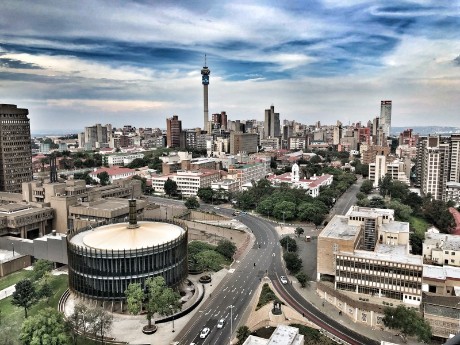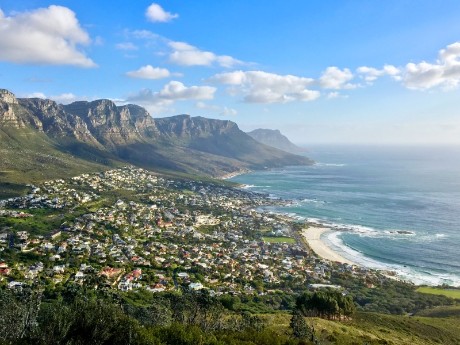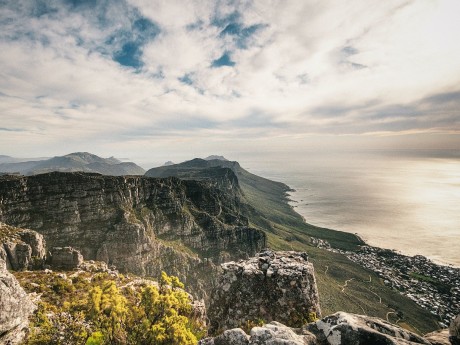South Africa: Johannesburg & Cape Town
Explore Johannesburg's history at the Apartheid Museum, Constitution Hill, and Soweto, a vibrant town known for its historical significance and landmarks like Vilakazi Street, where both Nelson Mandela and Desmond Tutu lived. Enjoy Gold Reef City thrills, a theme park built around an old gold mine, offering a glimpse into the city's mining history. Discover creativity in the Maboneng Precinct and wildlife at Johannesburg Zoo, along with ancient origins at the Cradle of Humankind.
Read more
Explore Johannesburg's history at the Apartheid Museum, Constitution Hill, and Soweto, a vibrant town known for its historical significance and landmarks like Vilakazi Street, where both Nelson Mandela and Desmond Tutu lived. Enjoy Gold Reef City thrills, a theme park built around an old gold mine, offering a glimpse into the city's mining history. Discover creativity in the Maboneng Precinct and wildlife at Johannesburg Zoo, along with ancient origins at the Cradle of Humankind. In Cape Town, encounter Table Mountain's majesty and Robben Island's significance. V&A Waterfront offers diverse experiences, while Kirstenbosch and Cape of Good Hope provide nature's tranquility. Penguins await at Boulders Beach, and Bo-Kaap's colours inspire. Cape Winelands beckons with vineyards and fine wines, combining history, culture, and beauty in these two cities. This enriching tapestry of experiences for travelers has vibrant urban centers and vast natural landscapes, a harmonious blend of cultures, wildlife, history, and adventure. Waterviews strives to offer accommodation options within walking distance of water and/or in an area of touristic interest. Our prices include taxes (but excludes local tourist taxes). Customize your trip to your personal preferences with optional activities (hit the “Add Activities’’) or change hotels, etc. Contact us for customization at no extra cost at: Service@waterviewstravel.com
Destinations
- Johannesburg
- Cape Town
Itinerary
Johannesburg

South Africa’s largest city is an urban, fast-paced metropolis which has undergone rapid redevelopment in recent years. The economic hub of the country and the gateway for international visitors, Johannesburg is bursting with energy. Learn about South Africa’s troubled past at the Apartheid Museum, or visit the upcoming and trendy Maboneng district before taking refuge in one of the city’s green areas such as the Botanical Gardens. Despite the wealth inequality, Johannesburg is a friendly and welcoming city which offers something for everyone.
Read more
South Africa’s largest city is an urban, fast-paced metropolis which has undergone rapid redevelopment in recent years. The economic hub of the country and the gateway for international visitors, Johannesburg is bursting with energy. Learn about South Africa’s troubled past at the Apartheid Museum, or visit the upcoming and trendy Maboneng district before taking refuge in one of the city’s green areas such as the Botanical Gardens. Despite the wealth inequality, Johannesburg is a friendly and welcoming city which offers something for everyone.
Additional Information
Johannesburg was formed after a gold rush in 1886 and is still a major employer in the city. It is also one of the wealthiest in South Africa. Shopping is popular with tourists and the city offers many beautiful shopping malls such as Sandton City, one of South Africa's upscale shopping experiences. Together with the adjacent Nelson Mandela Square, it forms the largest retail center in Africa. A pyramid-shaped roof was added in the 1990s and provides the distinguishing architectural feature. You can also find various markets such as the Oriental Plaza and the Rosebank Flea Market. Johannesburg has lots of wildlife and the Johannesburg zoo is one of the city's more popular destinations and one of the largest in South Africa. The city also has a Lion Park Nature Reserve near Lanseria, home to over 80 lions and various other animals. The Cradle of Humankind is 25 kilometers outside of the city as is designated a World Heritage Site. In the caves there, scientists discovered human fossils over 2 million years old and are some of the most significant discoveries that have helped us understand human origin and how we evolved as a specifies.
Cape Town

Overlooked by the spectacular Table Mountain, Cape Town is a modern and multicultural city home to a melting pot of cultures and breathtaking landscape. Although known for its natural wonders, Cape Town is a buzzing metropolis with vibrant nightlife, diverse cuisine and a huge creative scene - having been named a World Design Capital in 2014. Despite its long and troubled history, nowadays Cape Town offers a relaxed environment where visitors can enjoy this laid-back city and take advantage of its many attractions.
Read more
Overlooked by the spectacular Table Mountain, Cape Town is a modern and multicultural city home to a melting pot of cultures and breathtaking landscape. Although known for its natural wonders, Cape Town is a buzzing metropolis with vibrant nightlife, diverse cuisine and a huge creative scene - having been named a World Design Capital in 2014. Despite its long and troubled history, nowadays Cape Town offers a relaxed environment where visitors can enjoy this laid-back city and take advantage of its many attractions.
Additional Information
Cape Town is nicknamed the Mother City within South Africa. Compared to the more business oriented Johannesburg it is known for its relaxed and leisurely atmosphere. Some jokingly claim that the reason it is called the Mother City is that it takes at least 9 months to get anything done in Cape Town! Compared to other parts of South Africa Cape Town is also distinctly more "western", and South Africans from other provinces sometimes jokingly say they are traveling to Europe when visiting Cape Town.
Geography
The metropolis of Cape Town is spread over a wide area, from Somerset West and Durbanville in the east to Atlantis in the north and Cape Point in the south. The city centre is situated in a fairly small area between Table Bay and Table Mountain.
The original Dutch settlement, and the heart of the current city, is located south west of Strand St. In Afrikaans the name means "Beach street", since it followed the original waterfront during the 17th. Since then, centuries of landfills has successively moved the beach some northeast to its current position. The old city centre is intersected by avenues like Long St, St Georges Mall and Adderley St, and is approximately bounded by the Company Gardens in the southwest, the Castle of Good Hope in the east, and the slopes of Signal Hill in the northwest. During the 19th century these slopes were settled by Cape Towns muslim population, creating the area Bo-Kaap, which translates into "Above the Cape".
History
Before the European colonial era what is now the Western Cape was inhabited by Khoikhoi and San groups, whom the Dutch called "Hottentots", "Strandlopers" and "Bushmen" (note that these terms are now considered racist and offensive). From the late 15th century, European ships (primarily Portuguese) started to visit the area, firstly for fresh food and water, then later for whaling and trading with the locals. Cape Town's colonial history started in 1652, when founder Jan van Riebeeck established a trading post there for the Dutch East Indies Company (VOC), as a stopping point on the Cape Route. Even though South Africa is the part of Africa located furthest from Europe, it was the first, and up until the 19th century only place which was substantially colonized by Europeans. The reason is that the Cape, while being furthest from Europe, also is relatively far from the equator. The Europeans therefore found the climate temperate enough to grow European crops.
The earliest European settlers were predominantly Dutch along with some Protestant Huguenots from northern France fleeing from being persecuted by the Catholics. These settlers over time explored the adjacent hinterland and founded the cities of Paarl and Stellenbosch in what is today the Cape Winelands. They were known as Voortrekkers ("Pioneers"), and they ventured from the Cape region to explore, conquer and settle other parts of Southern Africa. The first people from Asia to arrive in Cape Town were the Malays from Java and other islands of the Dutch East Indies, brought in by the Dutch as slaves in 1654. Their descendants are today known as the Cape Malays. Soon the various ethnic groups intermingled leading to the emergence of the unique, mixed-race Cape Coloured community.
Political control of Cape Town ping ponged between the Dutch and British during the late 18th and early 19th centuries until 1814 when it was ceded to the British for good.
Cape Town, as the seat of parliament, is South Africa's legislative capital. The city was ahead of its time as it developed into a global, multicultural metropolis much earlier than most other major cities of the world. Cape Town has many fascinating points of interest, a thriving nightlife, and a sizable LGBT presence.
Climate
The months of summer are from December to February. The days are mostly hot but low in humidity, so you shouldn't feel uncomfortable. Stay indoors or at least in the shade during the midday heat and use adequate sunblock. International tourists jostle for space on the beach with the domestic beach-goers around the holiday period. However, it is still an exciting and eventful time to be in Cape Town. The months of winter from June to August are rather wet. It does not rain every single day though it can sometimes rain for two weeks straight. It can also get very chilly at night, with the mercury dropping to as low as (this temperature is comparable to the sea so it should not get any colder unless you head inland) but is more typical. It warms during the day, with typical temperatures between . The winters tend to be overcast with not as much sunshine. The ideal times to see the city are: October and November: Winter is over and the temperature is warming up. Spring has arrived, but it is not yet as warm as the middle of summer. This period is often windy too. The Southeaster is also called the Cape Doctor because a significant chunk of pollution gets blown away. December to February: These are the prime summer months with long, sunny and hot days. The sun sets late in the evening (staying bright up til 20:30 in December) with a lot usually happening. February is the most reliable month for weather, with day after day of warmth and sunshine. March to May: While this varies every year, it generally starts raining during the autumn period and the temperature starts to become cooler. The number of tourists around the city drops, giving you an opportunity to get great deals on travel services, including accommodation, activities and food.
Wildfire
During the dry summer months, especially when the winds are strong, wildfires pose a grave threat to the animals and vegetation of the Cape region. In particular, the fynbos in the national parks can become very dry and burn rapidly. Wildfires are a serious concern, and previous fires have damaged the slopes of Table Mountain. If you notice any fires in the Cape area please report them to the Western Cape Umbrella Fire Protection Association on +27 21 6897438, or the after-hours emergency hotline on +27 21 9574700.
© Sourced from Wikivoyage





